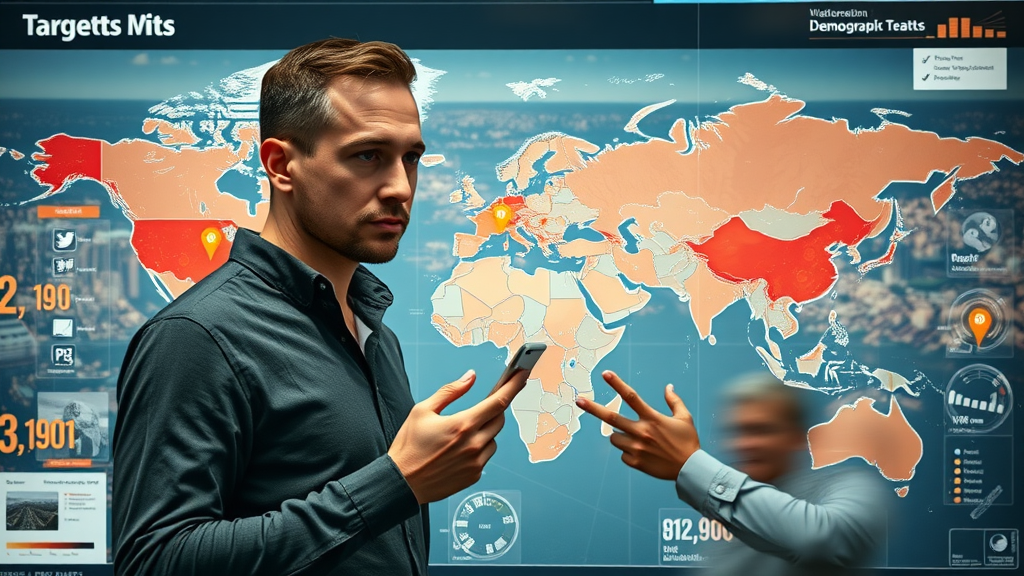Did you know that while the average click-through rate for online banner ads is just 0.05% , campaigns using the right strategies can generate clicks at ten times that rate or more? Banner advertising remains one of digital marketing’s fastest, most versatile tools for scaling sales and growing brand awareness—if you know the secrets the pros rely on. In this comprehensive guide, you’ll discover 20 actionable tactics for banner ads and display advertising that deliver measurable results quickly.
Why Banner Advertising Still Dominates Digital Marketing Success
Banner advertising has retained its place at the forefront of digital marketing for over two decades—outlasting trends and adapting to every change in online ad technology. The reasons are clear: banner ads offer unrivaled versatility, with diverse ad sizes , formats , and placements to engage both broad and niche audiences. Whether you’re driving traffic to a new landing page , promoting a free trial, or retargeting web visitors, banner ads let you instantly amplify your message with creative visual impact.
Modern banner ad campaigns leverage intelligent targeting tools, optimized design, and real-time ad analytics to reach the right users at the right time. Their low production barrier, automated scaling, and performance tracking also make banner advertising ideal for both large brands and small businesses seeking to compete in the crowded world of digital advertising . With continuous innovation—from interactive ad formats to mobile responsiveness—banner ads are engineered for today’s fast-moving web.

‘Online banner ads generate an average CTR of 0.05%, yet when optimized, they can reach up to 10x performance.’
What You’ll Learn: Banner Advertising Techniques That Drive Results
Understand banner ad fundamentals
Identify high-converting banner ad sizes and formats
Leverage advanced banner advertising targeting
Discover strategies for designing effective banner ads
Maximize ROI with landing page optimization
Banner Advertising Essentials: Everything You Need to Know
To unlock the full potential of banner advertising , it’s essential to master the building blocks—design, ad size, placement, and messaging. Every banner ad serves as a direct bridge between your target audience and a compelling digital offer, whether that’s a product sample, an exclusive deal, or the start of a buyer’s journey on your landing page . Savvy marketers continually refine their approach, balancing bold creative with strategic data analysis to maximize conversion rates and minimize wasted ad spend.
Effective banner ads blend visual attraction, persuasive ad copy , and intuitive CTA buttons with perfect alignment to campaign objectives. With so many options for ad format and ad space , understanding which combinations yield the best results—and adapting to trends such as mobile-first design or interactive advertising—puts your campaign ahead of the competition. From static display ads to dynamic HTML5 banners, know-how is your greatest asset in this game.

Breaking Down the Anatomy of a Banner Ad
A successful banner ad seamlessly integrates several key components. First, your ad copy —concise, action-oriented text meant to grab attention and clearly communicate value. Next, visual elements like logos, product images, and brand colors establish identity and intrigue. Lastly, an unmistakable CTA button (call-to-action) compels users to click, transitioning them to a targeted landing page designed for conversions.
The arrangement of these elements within the ad space can make or break user engagement. Eye movement studies and A/B testing show that clarity, contrast, and minimalism outperform cluttered designs, especially on smaller screens and modern responsive banners. With a pulse on evolving audience behaviors, refine your banners to maintain high visibility, increase brand awareness, and drive targeted actions.
Advanced banner advertisements may layer additional features like interactivity (hover effects, carousels), animation, or dynamic personalization based on user data. Each element should align with your campaign goal—whether that’s boosting sales, promoting a limited-time free trial, or raising brand awareness on premium display networks.
Types of Banner Ads: Display Ad, Advertising Banner, and More
Banner advertising spans a spectrum of formats and delivery methods, each tailored for different goals and platforms. The most common type is the display ad , commonly found on websites, apps, and email newsletters. These can be static images, animated GIFs, HTML5-rich media, or even interactive banners that engage users mid-scroll. Advertising banners also appear on social networks and programmatic ad networks, maximizing reach at scale.
Choosing between varied ad formats —such as leaderboards, skyscrapers, and rectangles—impacts visibility, audience targeting, and mobile responsiveness. The mix of ad sizes and placements you select should reflect your unique audience profiles and campaign objectives, from boosting conversion rates to sustaining ongoing brand recognition.
Let’s compare banner ad types , use cases, and recommended platforms in a handy table:
Banner Ad Type |
Use Case |
File Format |
Best Platforms |
|---|---|---|---|
Leaderboard (728x90) |
High-visibility desktop placements, navigation bars |
GIF, JPG, HTML5 |
Websites, Blogs, Forums |
Medium Rectangle (300x250) |
In-content display, mobile and desktop compatibility |
GIF, JPG, HTML5 |
Google Display Network, AdSense, Mobile Apps |
Skyscraper (160x600) |
Sidebar visibility, long-scroll engagement |
GIF, JPG, HTML5 |
News Sites, Community Portals |
Animated/Interactive HTML5 |
Brand engagement, dynamic offers |
HTML5 |
Media Networks, High-Traffic Sites |
Mobile Banner (320x50) |
Mobile-first campaigns, app advertising |
GIF, JPG, HTML5 |
Mobile Apps, Gaming Platforms |
Top 20 Banner Advertising Secrets: List of Must-Try Strategies
We’ve distilled decades of online advertising expertise into these essential steps. Implement these tactical secrets and watch your banner ad campaign performance surge.
1. Select Banner Ad Sizes That Guarantee Maximum Exposure
Not all ad sizes are created equal. Choosing high-performing banner ad dimensions ensures your ads appear in premium ad spaces across top websites and networks. The medium rectangle (300x250), leaderboard (728x90), and mobile leaderboard (320x50) dominate both placement and click-through metrics, giving your digital ad maximum reach and engagement.
Ad Size |
Placement Frequency |
Avg CTR (%) |
|---|---|---|
300x250 (Medium Rectangle) |
55% |
0.15 - 0.21 |
728x90 (Leaderboard) |
25% |
0.11 - 0.17 |
160x600 (Skyscraper) |
8% |
0.10 - 0.14 |
320x50 (Mobile Leaderboard) |
6% |
0.14 - 0.22 |
Align your chosen ad sizes with your target audience’s device preferences and where they’re most likely to notice your brand—above the fold on web pages, within content, or on mobile screens.
2. Smart Placement of Banner Ads on Landing Pages
Even the best banner ads can underperform if they’re in the wrong ad space . Strategic placement above the fold, within editorial content, or integrated into high-traffic sections is proven to increase user engagement. If your display ad invites users to click through, ensure it leads to a seamless, relevant landing page that matches the messaging and creative elements in your ad campaign.
Use web analytics to identify the zones with the most attention and test various ad placements to pinpoint what generates the highest conversion rate. Don’t overload pages with too many ads; instead, focus on visibility, relevance, and user journey optimization.

3. Craft Banner Ad Copy That Demands Attention
Persuasive banner ad copy cuts through the noise, speaking directly to your target audience’s pain points and offering quick, clear solutions. Keep headlines short (under eight words) and use bold verbs, strong value propositions, and urgency (“Act now!” “Limited-time free trial!”) to boost click-through.
Supplement your main message with supporting text that’s equally concise, then pair with a vibrant CTA button . Effective ad copy not only encourages users to click, but also previews the experience or reward that awaits them on your landing page .
Regularly A/B test new ad copy to determine which combinations resonate best—sometimes a tiny tweak in phrase or tone can result in a dramatic spike in conversions.
4. Eye-Catching Images and Branding for Your Advertising Banner
Visuals carry the weight of first impressions . Use crisp, high-resolution images, your recognizable logo, and a cohesive color palette to anchor your brand identity. Memorable graphic elements or product shots evoke emotions and increase your ad’s shareability. Strong branding not only boosts recognition but also improves perceived trust—crucial for nudging users to click.
Don’t forget the psychological power of color. Blues and greens foster trust, reds and oranges signal urgency, and whitespace keeps banners feeling uncluttered and professional. With so much competition, memorable design is your shortcut to top-tier brand awareness .

5. Responsive Banner Ad Formats for Every Device
With digital traffic now dominated by mobile, your banner ads must adapt to every screen and device. Use responsive ad formats —HTML5 banners that fluidly resize to fit desktops, tablets, and smartphones. This ensures no missed opportunities, regardless of where your audience browses.
Responsive display advertising not only improves reach but also delivers faster load times, better user experiences, and higher conversion rates. Make periodic device-testing a routine step in your campaign workflow to ensure design integrity everywhere.

6. A/B Testing Your Banner Ads for Rapid Results
Never rely on guesswork—use A/B testing to compare ad copy , images, color schemes, and ad sizes . Split your campaign audience and measure performance: Which types of banners attract more users to click, convert, or linger on your landing pages ? Small refinements—like a more descriptive headline or contrasting CTA button —can unlock dramatic performance gains.
Effective banner advertising means never standing still. Continual experimentation across every element (layout, visuals, offers) sharpens your messaging and keeps your digital ads fresh.
7. Utilizing Animated and Interactive Banner Ads
Animated banner ads grab attention through movement and creative transitions. Subtle animation (like sliding text, subtle zooms, or interactive features where users engage with the ad) can increase engagement rates across devices. HTML5 formats make it easy to add layers of interactivity—think swipeable carousels, rollover reveals, and clickable options.
Interactive ad formats deliver richer user experiences and provide valuable data on how users engage, helping you refine both banner advertising tactics and product offerings based on real behaviors.

8. Leveraging Display Ads on Niche and High-Traffic Sites
Strategic media buying starts with understanding where your target audience spends their time. Place display ads on relevant niche sites or alongside premium content read by your ideal customers. This approach ensures your ad campaign is both visible and credible—particularly for small businesses competing with big brands.
High-traffic sites deliver scale, while niche placements offer relevance. Split your ad spend intelligently between both, then track which platforms fuel the best conversion rates by cross-referencing performance data.
9. Geo-Targeting and Demographic Segmentation in Banner Advertising
Modern banner advertising platforms empower marketers to target users by region, city, device, language, age, gender, interest, and even intent signals. This granular target audience segmentation maximizes relevance and return on every ad spend dollar.
Segment your audiences and deliver tailored ad campaigns to different groups—NYC visitors get local event banners, returning shoppers receive personalized recommendations, and so on. This personalization is proven to lift engagement and sales.

10. Avoiding Banner Blindness with Creative Rotations
Banner blindness—a phenomenon where users unconsciously tune out standard ad placements—can sabotage even the most creative campaign. Avoid it by regularly rotating your creative assets, varying ad sizes , imagery, and copy.
Creative testing not only refreshes your digital ads but also provides ongoing learning about what keeps your target audience engaged. Adaptive, evolving campaigns help circumvent both user fatigue and platform algorithm downgrades.
11. Ensuring Fast Load Times for Every Banner Ad
Slow-loading banners hurt user experience and can halve your click-through rates or worse. Use compressed files, efficient ad format choices, and reliable servers to ensure each banner ad appears instantly, especially on mobile or variable network conditions.
Prioritize HTML5 over flash, limit file sizes to under 150KB, and always test banners in live environments before launching on high-traffic channels. Lightning-fast load times are a secret weapon for conversion rate optimization.
12. Mobile-First Advertising Banner Strategies
With most web usage shifting to mobile, mobile-first banner ads are essential. Design with touch interaction, legible text, big CTA buttons, and fast load times in mind. Prioritize vertical ad sizes and formats that work seamlessly within app environments and on-the-go browsing.
Mobile banners also take advantage of unique targeting—think location-based ads or push-to-call CTAs—turning brief moments of attention into measurable sales and leads.

13. Retargeting Users with Personalized Banner Ads
Only a fraction of new web visitors convert on their first visit. Use retargeting to serve personalized banner ads to users who’ve already shown interest—reminding them of abandoned carts, upselling related products, or offering a discount to complete their journey.
Retargeting dramatically lifts conversion rates and ensures your brand remains top-of-mind as users navigate research, comparison, and purchase cycles across the open web.
14. Integrating Banner Advertising with Social Ad Campaigns
Cross-pollinate your banner advertising efforts with synchronized creative across social media platforms—Facebook, Instagram, LinkedIn, and more. Consistent messaging and branding reinforce your ad copy , boosting both brand awareness and response rates.
Analyze which social audiences are responding best, then refine your display ad targeting on external networks accordingly for maximum impact.

15. Tracking Conversions: Banner Ad Analytics That Matter
Comprehensive analytics let you measure every step from impression to conversion. Monitor key metrics like impressions, CTR, cost per click (CPC), cost per acquisition (CPA), and—most importantly—post-click actions on your landing page .
Set up conversion tracking, use UTM codes, and integrate with analytics platforms (like Google Analytics) to uncover which creative, placement, and format choices generate the best ROI.
16. Programmatic Banner Advertising for Automated Success
Unlock the power of software-driven, auction-based ad buying with programmatic banner advertising. These platforms automatically match your creative to the best ad space and audience at the lowest possible price, while optimizing placements in real time.
Programmatic campaigns make true personalization and scale affordable—even for small businesses. Harness automation to bring data-driven efficiency to every ad spend dollar.
17. Keeping Your Brand Voice Consistent Across Banner Ads
A consistent brand voice—from language style to visual design—builds trust and recognizability in a crowded marketplace. Create brand guidelines for banner advertising and ensure every agency, designer, or tool follows them across every campaign touchpoint.
Consistency across your banner ads fosters stronger emotional connections with your target audience and streamlines the user journey across multiple devices and platforms.

18. Creative Banner Ad Campaigns that Went Viral
Some of the web’s most effective banner ad campaigns succeeded because they broke the rules. Unique visuals, daring humor, or interactive twists often get picked up by audiences and shared across social media, delivering awareness far beyond your paid ad spend .
Study the most memorable campaigns for inspiration—think: gamified offers, “choose your adventure” banners, or ultra-clever use of topical events and memes that naturally invite users to engage.
‘A creative approach can lift banner ad engagement by over 200%.’
19. Monitoring Banner Ad Spend to Maximize Budget
Set clear performance goals (CPA, ROAS, conversion rate) and monitor your ad budget in real time. Use analytics dashboards to pinpoint waste, shift funds to your highest-performing ad placements , and reinvest winnings into fresh creative or expanding your reach.
Efficient banner advertising isn’t about spending more—it’s about spending smarter, continually optimizing to ensure every penny produces a measurable impact.
20. Compliance and Best Practices for Banner Advertising
Adhere to advertising network requirements (Google, IAB standards) regarding file size, animation length, and content restrictions. Always include privacy notifications and opt-out options when using data for targeting. Respect user privacy and transparency to avoid penalties and reinforce brand integrity.
Regular compliance checkups protect your accounts, campaigns, and most importantly, your credibility in the digital marketplace.
Optimizing Banner Advertising for Improved Landing Page Conversions
Your banner ad is only as strong as the landing page it leads to. Ensure every click finds a dedicated page that matches banner messaging, colors, and visual cues—this seamless flow reinforces trust and boosts conversion rates. Avoid jarring disconnects between ad copy and on-page content; users should see exactly what they expected from the ad.
Continually refine your process by analyzing bounce rates, time-on-site, and user paths from banner click to conversion. This data-driven approach empowers ongoing optimization and greater ROI from every display advertising effort.
Aligning Banner Ads With Target Landing Pages
Before your next banner ad campaign , audit your landing pages : Are the images, messaging, and offers tightly integrated with your digital ad creative? Creating a streamlined experience increases user confidence and moves buyers smoothly through your marketing funnel.

Testing Banner Advertising Offers and CTAs
The best CTA buttons and offers often differ by device, seasonality, and audience segment. Test “Buy Now,” “Claim Offer,” and “Get Your Free Trial” against one another—and always track which drives the highest conversion rate. Split-test page headlines, form fields, and offer types for compound gains.
Comparing Banner Ad Formats: Which Works Best for Your Goals?
Choosing the right ad format depends on campaign objectives, creative assets, and audience context. Here’s a quick breakdown:
Banner Ad Format |
Pros |
Cons |
Best Used For |
|---|---|---|---|
Static Display Banner |
Simple, fast load |
Low engagement |
Branding, awareness |
Animated Banner |
Increased attention |
Bigger file sizes |
Sales, promotions |
HTML5 Interactive Ad |
User engagement, dynamic |
Complex to design/test |
Product demos, retargeting |
Responsive Banner |
Works on all devices |
Design flexibility required |
Omnichannel campaigns |
Expert Insights: Banner Advertising Quotes & Industry Data
‘Display ads produce measurable impact only when tailored to audience needs.’
Leading marketers agree that display advertising is most powerful when paired with personalization, strong creative, and constant optimization. Data-driven, audience-focused campaigns can consistently outperform generic banners—no matter the ad size or platform.
Video Case Study: Banner Advertising In Action
To see these tactics in the real world, explore video case studies demonstrating how businesses have doubled or even tripled online conversions by refining their banner ads . Look for real-time ad placement examples, before-and-after analytics, and interviews with industry pros who share their creative processes and failures as well as successes.
Frequently Asked Questions about Banner Advertising
What is the main purpose of a banner ad?
Banner ads are designed to increase visibility, drive clicks to landing pages, and foster brand recognition and engagement, providing a measurable catalyst for sales growth.
How much does a banner ad cost?
Banner ad pricing varies widely based on size, format, placement, and targeting—ranging from a few dollars per 1,000 impressions to hundreds for premium display ad positions.
How do banner ads pay?
Banner ads pay by CPM (cost per mille), CPC (cost per click), or CPA (cost per acquisition), depending on your campaign objectives and ad network agreements.
Why are banner ads effective?
Banner ads are effective for quickly scaling brand awareness, providing direct pathways to targeted landing pages, and offering flexible formats that cater to different business objectives.
List of Banner Advertising Tools to Supercharge Your Campaigns
Google Display Network
Canva
AdEspresso
Moat
Bannerflow
AdRoll
Summary: Key Takeaways to Accelerate Your Banner Advertising Success
Strategic placement and sizing drive results
Creative copy and visuals increase engagement
Continuous A/B testing and analytics optimize spend
Landing page alignment is essential
Leverage modern tools for scalable campaigns
Get Ahead of the Competition: Start Dominating with Banner Advertising Now
Ready to boost your sales performance with proven banner advertising secrets? Apply these 20 strategies, track your analytics, and watch your brand outshine the competition—starting today! To learn more read The Ultimate Guide to Paid Advertising
 Add Row
Add Row  Add
Add 




Write A Comment